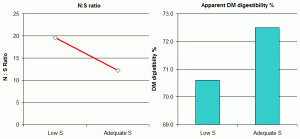Disappointing first cut yields due to drought are no reason to neglect potash and sulphur
June 2011
Yields of first cut grass have been lower than average in many parts of the UK. Pockets of the south west and N Ireland aside, yields down by as much as 30% have been reported from Wales, Scotland and the midlands, north west and north east of England. Some grassland farmers may have delayed cutting to allow swards to bulk up, but with dry conditions encouraging early heading, this tends to exacerbate poor quality as stem elongation rushes on apace.
A poor yield and/or quality of first cut puts the pressure on second cut to perform and make up some of the difference before winter arrives with what could be high concentrate feed prices. But the temptation to cut back on potash and sulphur should be resisted as these two elements are essential to making the most out of the remainder of the grass growing season to grow as much quality grass as possible.
Potash removal
Yields might be down, but grass still removes large quantities of potash from the soil.
| Table 1. Potash removed (kg K2O/ha) in first cut silage. | ||
| Yield | Grass for 25% DM silage | Grass for 30% DM silage |
| tonnes fresh grass/ha | kg K2O/ha removed | |
| 10 | 60 | 72 |
| 15 | 90 | 108 |
| 20 | 120 | 144 |
| 25 | 150 | 180 |
| Adapted from Defra Fertiliser Manual (RB209) | ||
A 30m3/ha application of 6% DM cattle slurry onto the aftermath will provide 87 kg/ha of available potash, which only just covers the potash removed from a disappointing 15 t fresh weight/ha first cut (3.75 to 5 t DM/ha). So, unless soil potassium reserves are high (Index 3 and above), even low yields followed by no replenishment will result in a rapid decline in soil reserves on most soils.
Potash for grass yield and quality

It should not be forgotten that, unlike nitrogen and sulphur, potash moves very slowly in the soil. This means that failure to replenish the potash removed by grass cut for silage can lead to real short-term yield penalties. The advice to keep soil potassium levels at Index 2- allows for the fact that this will maintain a fertile and productive soil throughout the soil horizon where the roots of grass plants can access nutrients. Fresh potash, whether from organic manures or inorganic fertilisers will not all be used to support grass growth straight after application; because potassium moves so slowly in the soil, the grass roots will not be able to access all the potash from fresh applications. Add to this the fact that fresh applications will also be partly used to replenish soil reserves where potassium soil levels have been allowed to fall (see Figure 1), and it is clear that maintaining soil reserves at Index 2- is critical to supporting yield throughout the growing season.
It is often forgotten that potash is important for achieving good grass quality as well as yields. In plant cells, potassium has two main functions. Firstly, it has an irreplaceable part to play in the activation of enzymes which are fundamental to metabolic processes, especially the production of proteins and sugars. In grass then, a potash deficiency reduces not just growth, but quality also, with true and crude protein levels and soluble sugars concentrations at risk.
The second role for potassium in plants is as the ‘plant preferred’ cation for maintaining the water content and hence the rigidity and shape (turgor) of each cell. The concentration of potassium in the cell sap (the liquid inside a plant cell) creates conditions that cause water to move into the cell (osmosis) through the semi-porous cell wall. Turgid, well-shaped plant cells maintain the leaf’s vigour so that photosynthesis can proceed efficiently. Large amounts of potash are needed for this function and a lack of potash will lead to inefficient photosynthesis, compromising nitrogen uptake which causes low protein levels as well as yield reductions.
Luxury uptake by grass? It’s a myth!
Because such large amounts of potash are needed to maintain the rigidity and shape of grass, it often appears that there is ‘luxury uptake’ of potash from soils and fertilisers. This concept of ‘luxury uptake’ is wrong; plants take up as much potash as they need to maintain shape and turgor, and no more. Other cations, such as sodium (Na), can substitute to some extent, but potassium is the ‘preferred’ cation and will be taken up in preference to other cations from soil solution.
Remember sulphur as well
According to the British Survey of Fertiliser Practice, there are still only around 15% of grass cutting swards receiving fertiliser sulphur. This is worrying when one considers that even grass grown on medium soils, let alone lighter soils, will be responsive to sulphur. Grass growth tends to be more responsive to sulphur as the season progresses, so it is critical to get sulphur use right on aftercuts, especially where the pressure is now on second cut after disappointing spring growth.

It could be argued that the apparent lack of sulphur fertiliser use on grass is partly due to the assumption that slurry applications on aftermaths will provide enough readily available sulphur as sulphate for the following crop. Indeed, it is easy to see where this presumption comes from when one considers that a 30 m3/ha application of 6% DM cattle slurry to an aftermath will supply 21 kg SO3/ha, which is pretty close to the 25-30 kg SO3/ha that the grass crop needs for the next cut of silage. But the availability of this sulphur from the slurry is variable and probably low, due mainly to being reduced from sulphate to sulphide under anaerobic storage conditions. Experimental studies give a range of sulphur availability from slurry for plant uptake of between <5% to 55%, and the new RB209 Fertiliser Manual states that ‘Sulphur … inputs from manures should largely be regarded as contributing [only] to the maintenance of soil reserves’. So, if soil reserves are low, then there is a problem.
It is impossible to notice visually a 10-15% yield response to sulphur in grass, but this level of response it typical and highly desirable. Therefore, using a sulphate fertiliser to supply the modest rate of 25 kg SO3/ha for a silage cut is a very low cost insurance policy against losing grass yield and quality.
Sulphur for quality

Good yield responses of grass to sulphur applications are common and proven by experimentation. However, just like potash, we tend to neglect the quality angle when considering sulphur applications. The role of sulphur in protein production, as a core element in two of the essential amino acids that make up the building blocks of protein, is often cited; sulphur does lead to higher levels of protein in grass when applied to deficient soils (Figure 2). But we must also consider that these proteins are used in the biochemistry of accumulating sugars in the plant through photosynthesis, so it should not be forgotten that sulphur deficient grass also tends to have lower levels of water soluble carbohydrates (WSC), which are important in the fermentation of good quality silage (Figure 3).
A shortage of sulphur also has an effect on the efficient use of forage. The rumen microbes also require both nitrogen and sulphur to produce their own protein, and a shortage of sulphur will mean that they ‘stop work’ when they have used it all up, even if there is still nitrogen and carbohydrate left for them to use. Thus the actual ‘D-value’ of the forage is reduced by a lack of sulphur, which is well illustrated in Figure 4 where an appropriate N:S ratio of about 12:1 provides much better true digestibility of feed.


